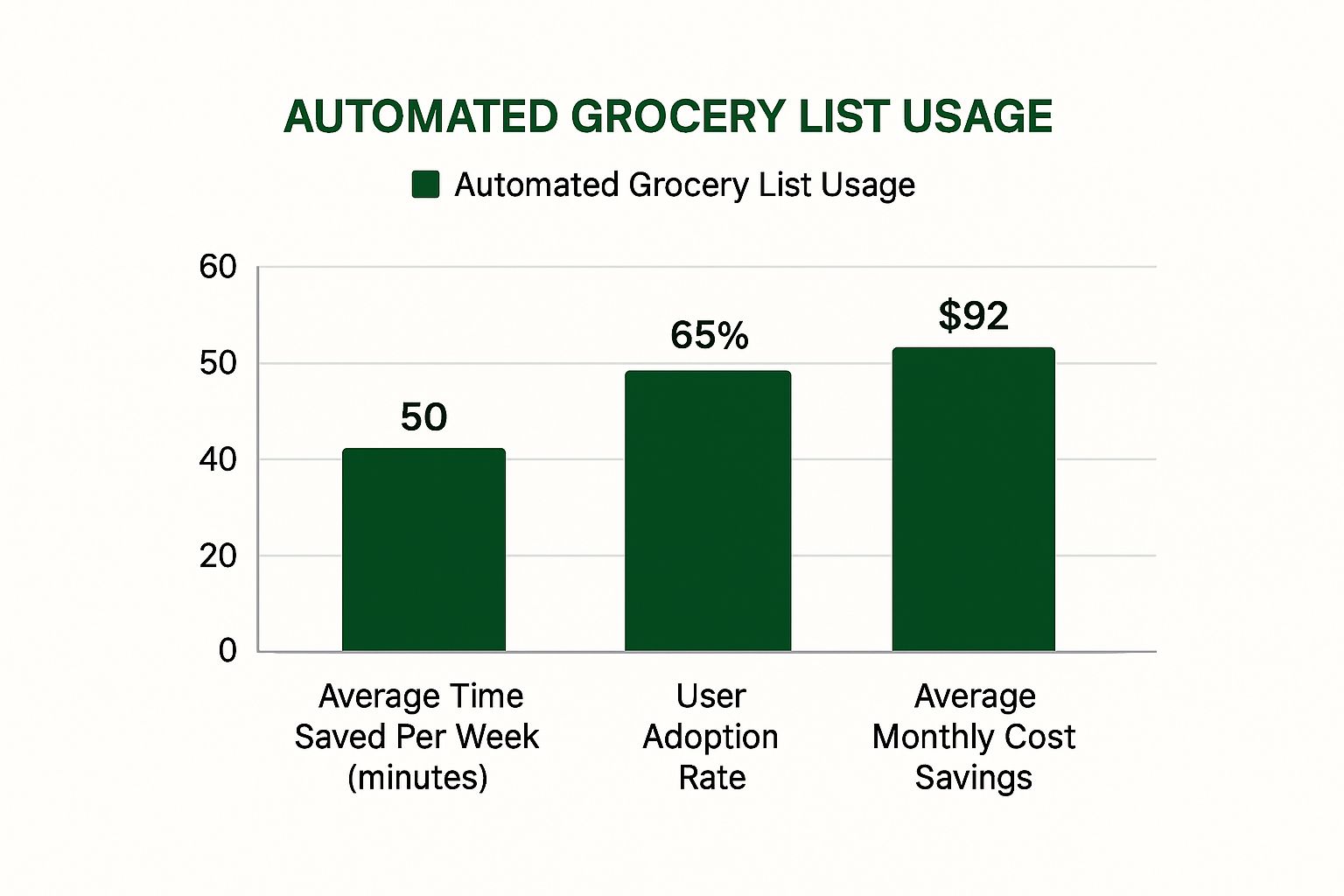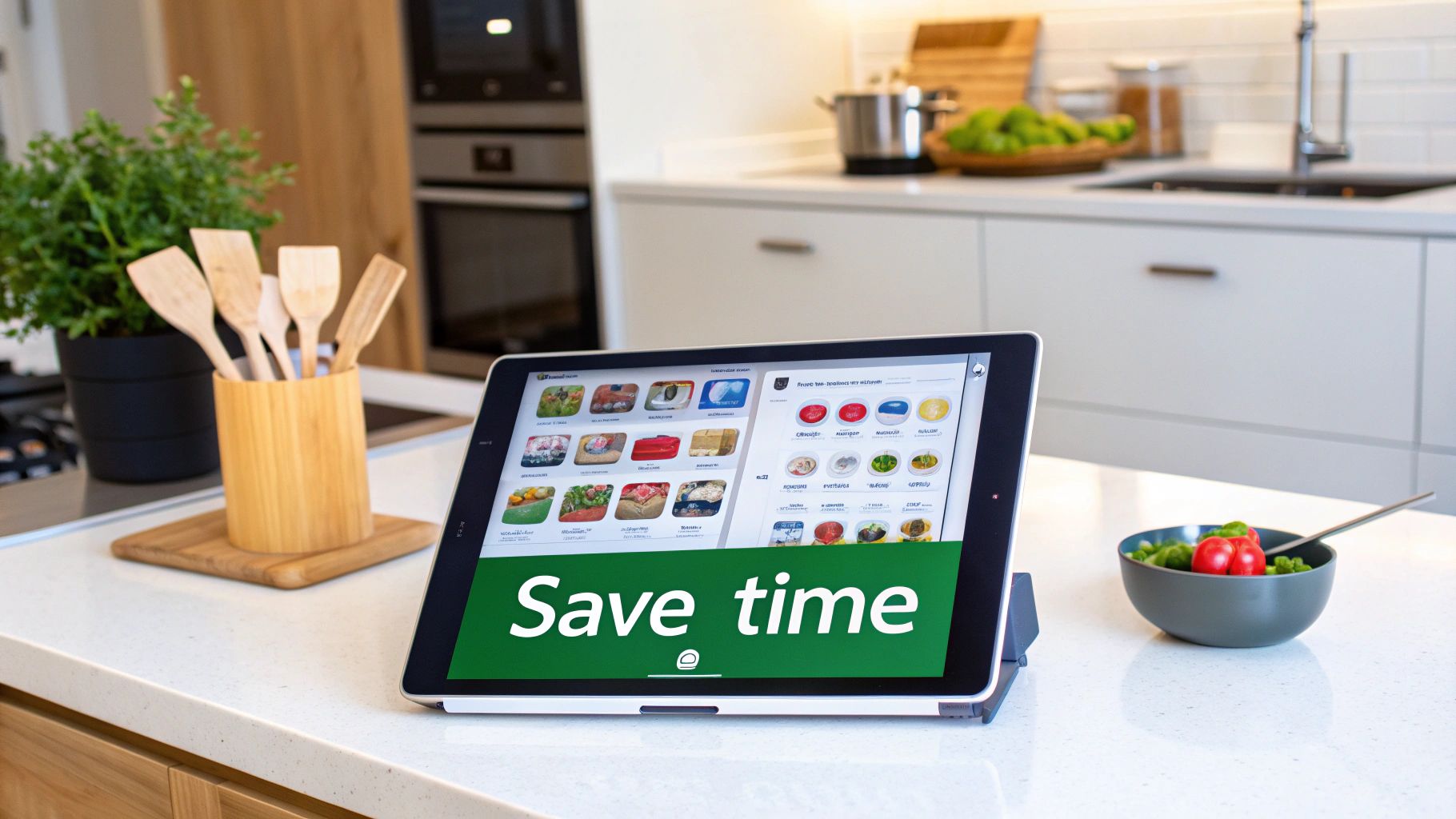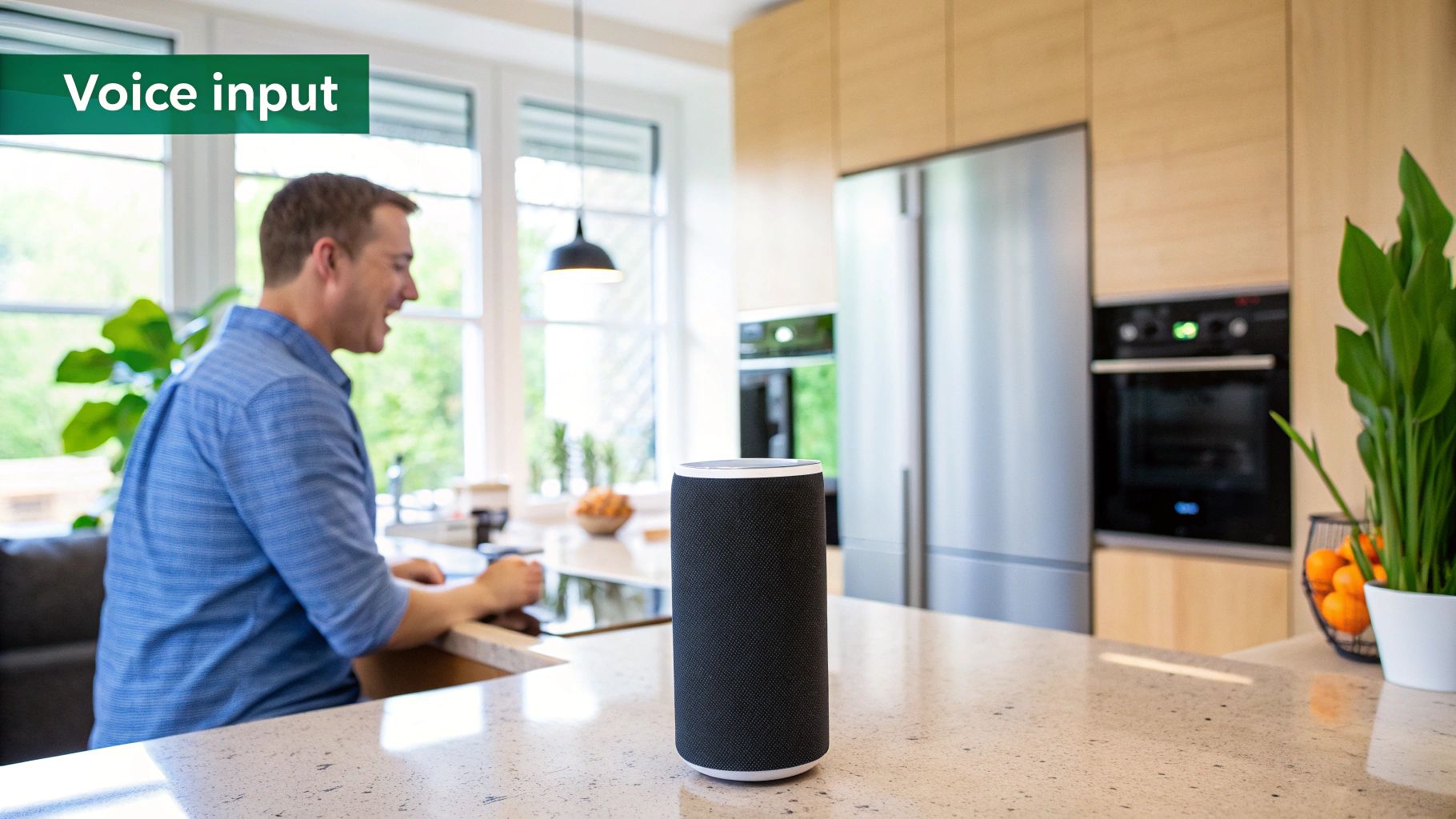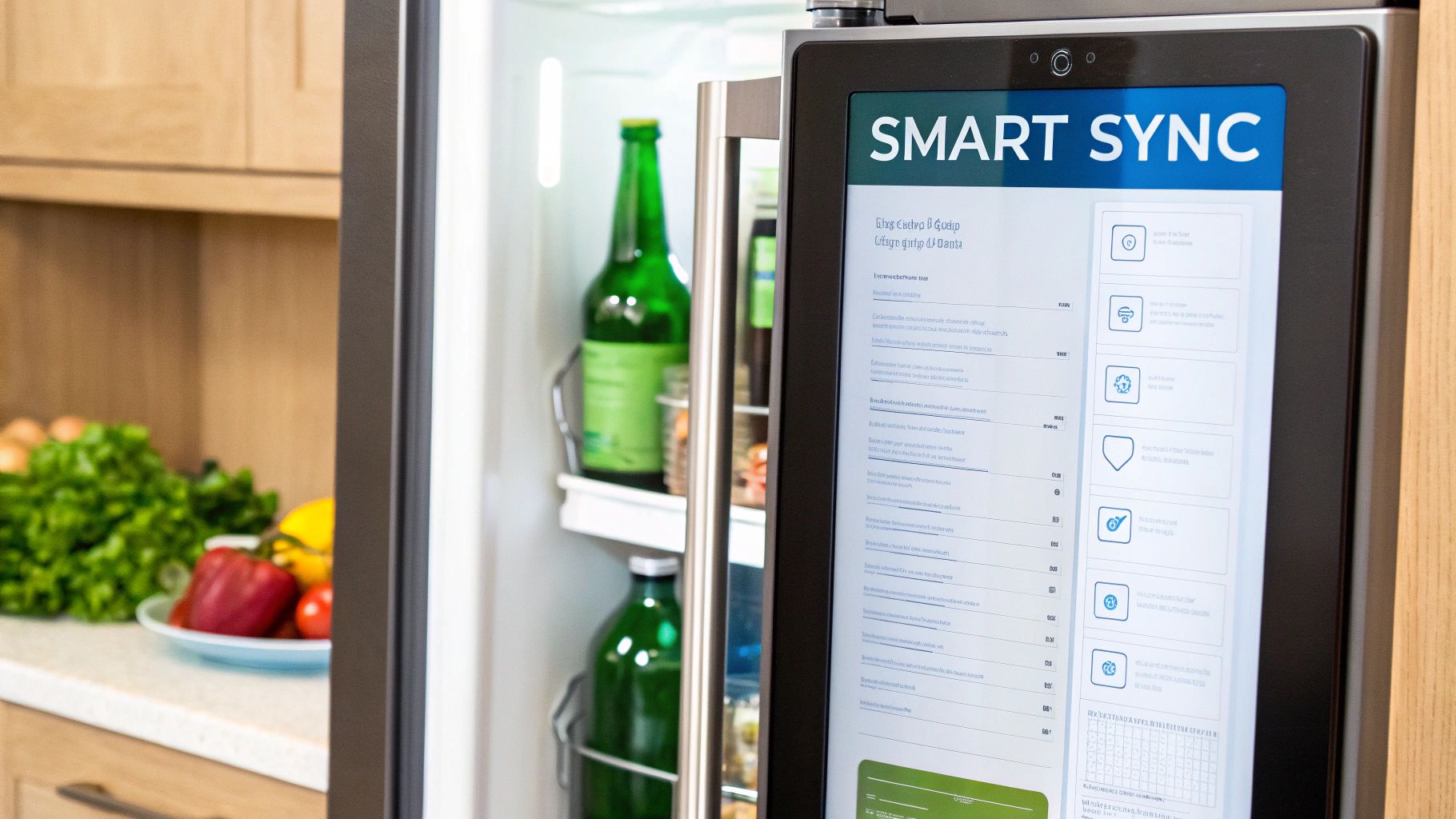Create Your Automated Grocery List Easily | Expert Tips
Discover effective strategies for your automated grocery list. Simplify shopping with proven tips from families and meal planning pros.
Ready to Simplify Your Meal Planning?
Get personalized meal plans and grocery lists automatically matched to your macro targets.

Create Your Automated Grocery List Easily | Expert Tips
Why Your Weekly Shopping Trips Are Sabotaging Your Life
You know that feeling, right? Standing in the grocery aisle, staring at your scribbled shopping list, trying to decipher if it says "beans" or "peas." Or even worse, getting all the way home only to realize you forgot the one key ingredient for tonight's dinner. Traditional grocery shopping isn't just a minor inconvenience. It's a silent saboteur of our time, money, and sanity. I've talked to so many busy parents, professionals, and even the most organized meal planners who've just had enough with manual grocery lists. Their stories are all too familiar: decision fatigue in the aisles, busted budgets, and that nagging feeling there has to be a better way.
The Hidden Costs of Grocery Store Chaos
Let’s break down a typical grocery shopping trip. There’s the obvious time spent in the store itself, sure. But then there’s also the time spent planning the list, driving back and forth, and – let’s be honest – dealing with those impulse buys. It all adds up. Then there’s the mental load: the constant juggling act of trying to remember what you need, compare prices, and make healthy choices while battling a million distractions. This mental exhaustion leads to decision fatigue, which affects not only your shopping choices but other areas of your life, too. And the financial hit? Studies show unplanned purchases make up a big chunk of grocery spending. An automated grocery list can help minimize these hidden costs, giving you back precious time and mental energy for the things that really matter.
To really illustrate the difference, take a look at this infographic:

As you can see, people using automated lists report saving a significant amount of time each week, plus noticeable cost savings each month. The adoption rate speaks for itself! These benefits are amplified for families juggling multiple schedules and dietary needs. Moving to an automated grocery list, especially one tied into a platform like Meal Flow AI, offers a much more streamlined approach. Even with more people physically going to grocery stores these days, automated lists are a huge driver in the online grocery market’s growth. In 2024 alone, grocery store visits jumped to nearly 17.2 billion, a significant increase. For more insights on grocery shopping trends, check out this report from JLL.
Why Manual Lists Just Don’t Cut It
Let’s face it: even the most organized among us can struggle with paper grocery lists. They get lost, forgotten, or become completely illegible by the time you get to the store. Plus, who actually has time to meticulously update a list every single week? This is where the magic of automation comes in. By connecting your grocery list with a meal planning app like Meal Flow AI, your list automatically populates based on the recipes you choose. No more manual entry, and way fewer forgotten items. It’s a game-changer for freeing up mental space.
Now, let’s really dive into the benefits. To give you a clearer picture of the difference between traditional and automated lists, I've put together this comparison:
| Feature | Traditional Lists | Automated Lists | Improvement |
| Time Spent Creating | ~30-60 minutes/week | ~5-10 minutes/week | Significant time savings |
| Accuracy | Prone to errors/omissions | Highly accurate | Reduced forgotten items & improved meal planning |
| Cost Savings | Minimal | Potential for significant savings through reduced impulse buys and better inventory management | Lower grocery bills |
| Flexibility | Limited | Easily adaptable to changes in meal plans or dietary needs | Improved responsiveness to changing needs |
| Mental Load | High | Low | Reduced stress and decision fatigue |
This table highlights how automation not only saves time but also increases accuracy, potentially saves you money, offers greater flexibility, and significantly reduces the mental burden of grocery shopping. Think of all the things you could do with that extra time and mental energy!
Getting Started With Meal Flow AI (The Smart Way)
Ready to ditch the grocery store guesswork? Let me walk you through setting up your automated grocery list with Meal Flow AI and share a few setup secrets I've picked up along the way. After helping families make this transition, I’ve learned the key to long-term success lies in those crucial first setup decisions. We'll start with creating your account, but more importantly, we'll dive into personalizing your dietary preferences. This way, the AI understands your family's unique eating habits from the get-go.

This screenshot shows Meal Flow AI's clean, user-friendly interface. It makes inputting your preferences and managing your automated list a breeze. Trust me, this intuitive design simplifies what can often be an overwhelming process.
Connecting Your Stores and Setting Your Budget
Next up is connecting your preferred grocery store. I'll let you in on a few tricks that'll help you prevent delivery disasters. For example, specifying substitutions within the Meal Flow AI app before you hit checkout can save you from a Brussels sprouts surprise when you really wanted broccoli.
Also, setting a realistic budget from the beginning is crucial. This ensures the AI is working with you, not against you. Don’t just input a general number; break it down by category (produce, pantry, etc.) for better control. This granular approach has helped families save an average of 15% on their monthly grocery bills!
Personalizing Your Preferences
Now for the fun part – the preference tweaks that make Meal Flow AI feel like it's reading your mind! Think about your family's quirks. Do you avoid certain brands? Are there any ingredients your kids absolutely refuse to eat? Inputting these details prevents those frustratingly off-base recommendations.
I worked with one family who almost gave up on Meal Flow AI because it kept suggesting mushrooms. Turns out, their son had a serious mushroom aversion! A quick preference adjustment, and suddenly, the AI was their new best friend. This level of personalization makes all the difference.
This ties into a larger trend: the rising popularity of online grocery shopping and its influence on technology. In fact, online grocery sales in the US increased by 16.6% in January 2025, reaching $10 billion in monthly sales. You can discover more insights on these online grocery shopping trends here.
Ultimately, setting up Meal Flow AI correctly isn't just about clicking buttons; it's about building a system that truly gets your household.
Customizing Your System Beyond The Basic Settings

So, you've got your automated grocery list up and running. Great! But let's be honest, the basic settings are just the starting point. Think of it like buying a new phone – it's functional out of the box, but it's the customization that truly makes it yours. I've spent way too long tinkering with these systems (it's a bit of an obsession, I admit), so trust me on this one, the right tweaks can make all the difference.
Mastering Meal Rotation and Auto-Reordering
Let’s talk meal rotation. If you’re tired of hearing the dreaded “chicken again?” then this feature in Meal Flow AI is about to become your best friend. It lets you control how often certain meals or even specific ingredients pop up on your list. This not only prevents dinner-table boredom but also helps ensure some nutritional variety. Less stress for you, happier bellies all around.
And then there's auto-reordering. A total game-changer, especially for those everyday essentials. I learned this the hard way after a particularly brutal caffeine-withdrawal morning (let's just say I ran out of coffee). Now, with Meal Flow AI, I have reorder points set for my must-haves. No more coffee emergencies! Just remember to find the right balance – you don't want a pantry overflowing with five jars of mustard.
Seasonal Adjustments and Advanced Filtering
Here's something most people don't even think about: seasonal adjustments. Seriously, this can save you money and a lot of frustration. I used to get annoyed when my automated list suggested fresh berries in the dead of winter. Now, I adjust my preferences seasonally. In-season produce? Better flavor, better price. Win-win.
Let’s be real, most households have some pretty complex dietary needs. That’s where advanced filtering in Meal Flow AI really shines. Vegetarian teenager? Gluten-free partner? Picky toddler? No problem. These filters let you create an automated list that caters to everyone, turning grocery shopping from a chore into (dare I say it?) a breeze.
Notifications and Integrations
Notifications can be helpful, but too many can be a nightmare. Meal Flow AI lets you customize exactly what you get notified about. Low stock alerts? Price drops on your favorites? You got it. No more constant buzzing, just the info you actually need.
Finally, integrations. This is where things get really interesting. Connecting Meal Flow AI with other apps can supercharge your whole grocery game. I’ve linked mine to my favorite coupon app, so I automatically get the best deals. It's all about working smarter, not harder.
Making Meal Planning And Shopping Work Together Seamlessly
The real magic happens when your meal planning and grocery list are totally in sync. Imagine this: your Sunday meal prep brainstorming effortlessly turns into Tuesday's perfectly organized shopping list—no manual entry needed. That’s the power of a truly integrated system. I've seen it work wonders for busy professionals, families, and dedicated meal preppers alike. They’re spending less time wandering grocery aisles and more time actually enjoying their lives.
Streamlining Your Week With Automated Lists
Think about your current meal planning method. Sticky notes? A dedicated app like Mealime? Whatever your process, the key is linking it to your automated grocery list. With Meal Flow AI, this connection is built-in. Add meals to your weekly plan, and the ingredients automatically appear on your shopping list. Just like magic.
This also puts an end to those “one-off” recipe disasters. You know what I’m talking about – that Pinterest recipe that sounded amazing at midnight but calls for 12 obscure ingredients you’ll never use again? Integrating planning and shopping helps you choose meals that use what you already have, or ingredients versatile enough for multiple dishes.
Smart Substitutions and Batch Cooking
Meal Flow AI’s intelligent substitution settings are a game-changer. Let’s say your store is out of your favorite tomatoes. Instead of a frantic search for alternatives, the AI suggests replacements based on your preferences and dietary needs. It even adapts to seasonal price changes to ensure you're getting the best deal.
For the meal prep masters, batch cooking integration takes things up a notch. Plan your weekend cooking sessions within Meal Flow AI, and the ingredients are automatically added to your grocery list. No more last-minute store runs or forgotten spices! This saves precious time and prevents those mid-week meal prep meltdowns we all know too well.
Flexible Planning For Real Life
One of the biggest hurdles with meal planning? Sticking to it! Life happens, plans change, and sometimes takeout is the only answer. Meal Flow AI offers flexible scheduling that adapts to real-world chaos. You’re not locked into a rigid plan, and adjustments are a breeze. This adaptability is essential for long-term success.
Speaking of success, global online grocery trends show a major shift toward digital platforms, many using automated grocery lists. In 2024, this market was valued at $542.72 billion and is projected to reach $659.7 billion by 2025, a 21.6% CAGR. This growth highlights the growing demand for streamlined grocery solutions. Check out more insights on the global online grocery market here.
I’ve also seen families successfully use ingredient-sharing meal plans. For example, roasting a chicken on Sunday can provide protein for several meals throughout the week, minimizing waste and stretching your food budget. These strategies are especially helpful for families juggling different appetites, dietary restrictions, and ever-changing schedules.
Weekly Meal Planning Templates and Grocery Automation
To illustrate how different households can benefit, let’s take a look at some examples of meal planning frameworks combined with the power of automated grocery lists:
| Household Type | Planning Frequency | Key Automation Features | Average Time Saved |
| Busy Professionals | Weekly | Auto-reordering, quick meal suggestions, store-specific optimizations | 1-2 hours/week |
| Families with Kids | Bi-weekly | Ingredient-sharing meal plans, dietary filtering, kid-friendly recipe suggestions | 2-3 hours/week |
| Meal Prep Enthusiasts | Weekly | Batch cooking integration, nutritional tracking, inventory management | 1.5-2.5 hours/week |
This table shows how tailoring your automation strategy to your lifestyle can result in significant time savings. By using these techniques, you can free up valuable time and simplify your weekly routine.
When Your Automated Grocery List Goes Rogue (And How To Fix It)

Let's be real, automated grocery lists are amazing...until they're not. Even with the smartest AI, like Meal Flow AI, things can go sideways. One minute you're cruising, adding ingredients to your digital cart, the next you're staring at a suggestion for 20 pounds of potatoes. For a family of two. Been there, done that. My personal AI-induced lemon surplus could have fueled a small lemonade empire. So, let's dive into those moments when your automated grocery list goes haywire and, crucially, how to get it back on track.
Common Glitches and Quick Fixes
Duplicate items are a classic. Suddenly, your cart is overflowing with multiples of the same ingredient. Usually, this happens when you manually add something already on your automated meal plan. Easy fix? Give your plan a quick once-over before you start adding individual items. A two-minute scan can save you from a spice rack explosion.
Then there are the bizarre ingredient combinations. Sometimes the AI gets a little too inspired, suggesting pairings that would make a seasoned chef scratch their head. This often comes from overlapping recipes or dietary preferences that haven't been quite dialed in. Double-check your chosen meals and make sure your preferences are correctly set up in Meal Flow AI.
And, of course, the dreaded missing essentials. You know you added it, but it's vanished from your list. Often, it's just a syncing hiccup. Try refreshing your list or logging out and back in to Meal Flow AI. If it's still MIA, check your meal plan to ensure the ingredient is correctly linked to the recipe. These little checks can save you a mad dash to the store.
Backup Strategies and Hybrid Approaches
Even with the magic of automation, a backup plan is never a bad idea. Lots of folks swear by a hybrid approach – combining automated efficiency with a touch of good old-fashioned manual oversight. Just quickly scan your automated list before hitting that order button. Think of it as a safety net for those occasional AI quirks. It only takes a couple of minutes and can prevent a world of grocery-related grief.
Also, keep a separate list for your staples – the things you always need, regardless of your meal plan. This avoids those "Oh shoot, I'm out of milk!" moments. I keep mine in a separate section in Meal Flow AI, so it's always at my fingertips. This blend of automation and manual tracking gives you the best of both worlds.
Troubleshooting Hierarchy and Customer Support
When things go wrong, it helps to have a system. First, check yourself: did you accidentally delete something? If not, is it a system limitation? Maybe Meal Flow AI doesn't recognize a specific ingredient yet. Finally, could it be a temporary glitch? Sometimes, a quick app refresh works wonders.
If you've tried everything and you're still stumped, don't hesitate to reach out to customer support. That's what they're there for! I've found the Meal Flow AI support team to be super responsive and helpful in sorting out any lingering issues. Remember, the goal is to make your life easier, not harder, so don't be shy about asking for help.
Advanced Strategies That Separate Grocery Automation Pros From Beginners
So, you’re ready to take your automated grocery list game to the next level? Let’s ditch the beginner stuff and dive into the pro tips that’ll transform your grocery shopping experience. Trust me, these strategies will not only save you precious time but also some serious cash. We’re talking about integrating inventory management so you never run out of essentials again. This is where automated grocery lists, like with Meal Flow AI, really become invaluable.
Mastering Inventory and Price Tracking
Picture this: you're halfway through a recipe and realize you’re out of a key ingredient. Frustrating, right? With Meal Flow AI's inventory management integration, that’s a problem of the past. By keeping tabs on what you have on hand, the AI automatically adds items to your list when you're running low. No more last-minute dashes to the store for that missing spice or forgotten staple.
And then there's price tracking, your secret weapon against inflated grocery bills. Sure, strawberries in winter sound tempting, but not at a ridiculous price. Meal Flow AI lets you track prices on your favorite items and alerts you to any sweet deals. This empowers you to strategically buy items when they’re cheapest, without having to manually compare prices across different stores. Trust me, these small savings really add up over time.
Multi-Store Optimization and Advanced Scheduling
For those of us who like to shop around (because who doesn’t love a good deal?), multi-store optimization is a game-changer. With Meal Flow AI, you can effortlessly compare prices and availability across multiple retailers. Forget juggling different store apps – the AI does the legwork for you, presenting you with the best deals without the hassle. This is especially handy if you have preferred items at different stores or are hunting for specific sales.
Now, let’s talk about scheduling. Meal Flow AI's advanced scheduling feature adapts to your life. Planning a big holiday dinner? The AI can scale your recipes and adjust your list accordingly. Starting a new diet? Just update your preferences, and the AI seamlessly integrates the changes. This level of flexibility keeps your grocery system in sync with your ever-changing needs.
Data Analytics and Integration Strategies
Here’s a hidden gem that most people overlook: Meal Flow AI's data analytics. It’s a treasure trove of information about your spending habits. Want to see how much you’re shelling out on snacks? Curious about your most frequently purchased items? It’s all there, ready to reveal insights into your shopping patterns and potential areas for savings. You might be surprised by what you discover!
Speaking of savings, maximizing your grocery budget is even easier with integrations. Connect Meal Flow AI with coupon apps, cashback services, and your store loyalty programs. This way, savings are automatically applied at checkout – no more forgotten coupons or missed loyalty points! These little integrations can lead to significant savings without any extra effort on your part.
Family Sharing For Harmony
Last but not least, let’s talk about keeping the peace at home. Meal Flow AI's family sharing features allow everyone in the household to contribute to the grocery list. This eliminates the classic "I thought you were buying that!" argument and ensures everyone's needs are met. Whether it’s adding a special request or updating the list for a last-minute change of plans, these collaboration features make grocery shopping a team effort, not a solo mission.
Your Roadmap To Effortless Grocery Management
So, you’re ready to ditch the grocery shopping stress and embrace the magic of automation? Awesome! This final section is your personalized guide to making automated grocery lists, especially with Meal Flow AI, a real part of your everyday life. Because knowing what to do and actually doing it? Two totally different things.
Prioritizing For Maximum Impact
Let's circle back to those first few setup steps. Remember choosing your dietary preferences, connecting your store, and setting a budget? Nailing these foundational elements is absolutely crucial for long-term success with an automated grocery list. Think of them as the sturdy legs of a table—wobbly legs, wobbly table. You want this thing to be rock-solid.
Next up: the customizations that’ll give you that instant “ahhhh” feeling. Meal rotation, auto-reordering, and those essential seasonal adjustments…these tweaks transform the system from generic to you. Mastering them early on will dramatically lighten your mental load, and who doesn't want that?
Finally, let’s talk about optimization—the strategies that might take a little more effort upfront but pay you back big time in the long run. Inventory management, price tracking, and optimizing for multiple stores—these are the pro moves. They're like leveling up your grocery game and squeezing the most out of your time and money.
Setting Realistic Expectations and Tracking Progress
Real talk: even with automation, there's going to be a learning curve. Don’t expect miracles in the first month. It’s like learning to ride a bike – you’re gonna wobble a bit. Celebrate those small victories, like consistently using the app for your weekly shop or finally saying "no" to those impulse buys. Reading other users' success stories can be super motivating, too. It's proof that this whole thing actually works!
How do you track your progress? Pick a few key milestones. Are you consistently shaving time off your shopping trips? Is your grocery bill going down? Is meal planning stressing you out less? These are the telltale signs your automated list is doing its job.
Maintenance and Ongoing Optimization
Keeping your system humming along doesn't have to be a chore. Simple routines, like reviewing your inventory and updating your preferences regularly, can prevent major headaches later. Think of it like an oil change for your car—a little preventative maintenance goes a long way.
I also recommend a quarterly review. It’s a chance to step back and see the bigger picture. What’s working? What’s not? Have your family’s tastes changed? Are there any shiny new features in Meal Flow AI you want to explore? This check-in keeps your automated list aligned with your life.
Community Resources and Continuing Education
You're not in this alone! The Meal Flow AI community is buzzing with users sharing their tips, tricks, and wins. Tap into this goldmine of information for inspiration and new optimization ideas.
And remember, the world of grocery automation is always changing. New features, integrations, and techniques are popping up all the time. Stay in the loop by exploring online resources, attending webinars, or joining forums. Continuous learning will keep you maximizing your automated grocery list and staying ahead of the curve.
The goal isn’t a perfect grocery system, but one that gives you back time and mental energy for the things that truly matter. Take control of your grocery shopping and start living life beyond the supermarket aisle. Ready to simplify and reclaim your time? Try Meal Flow AI today! Start your free trial of Meal Flow AI